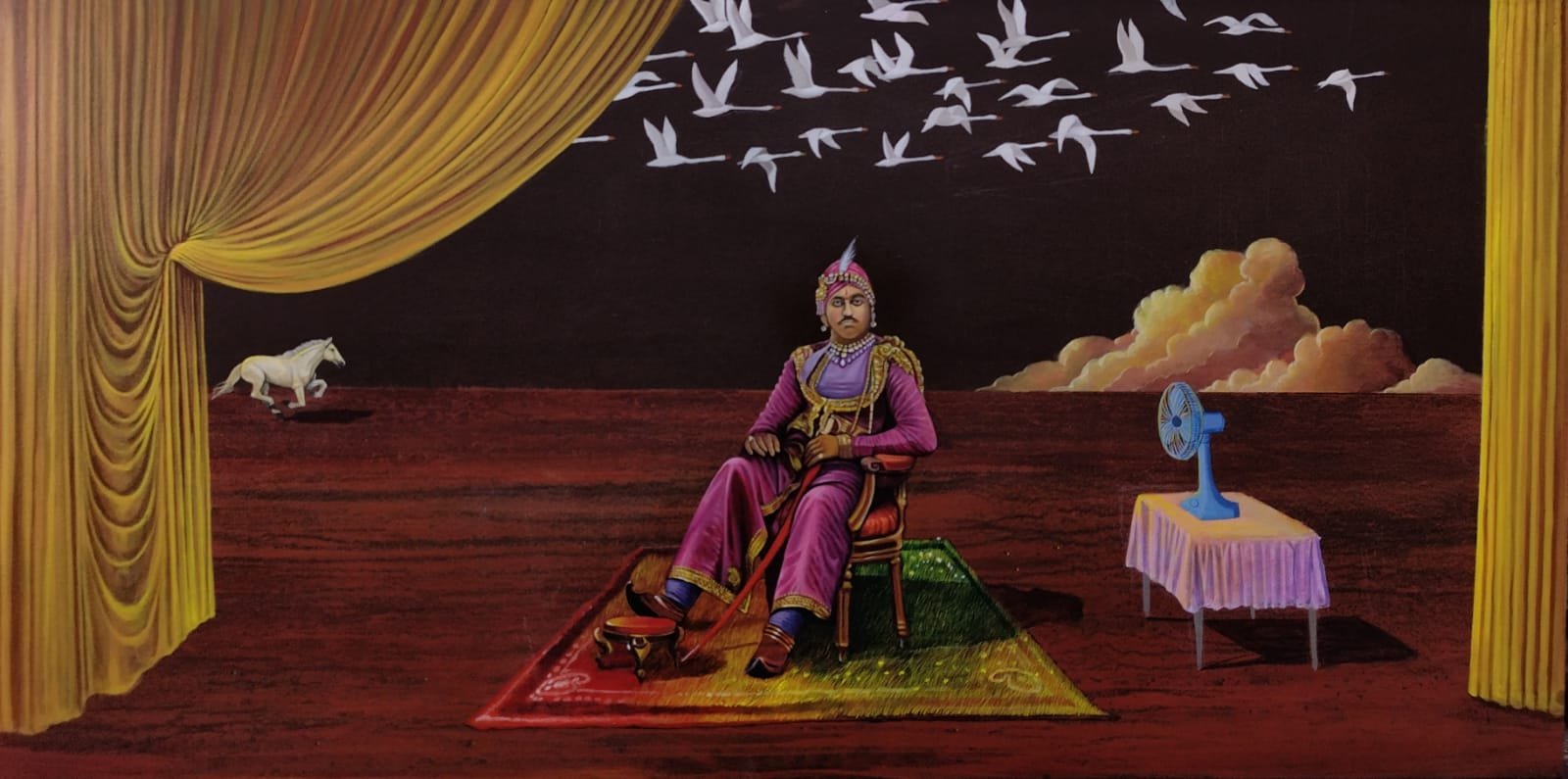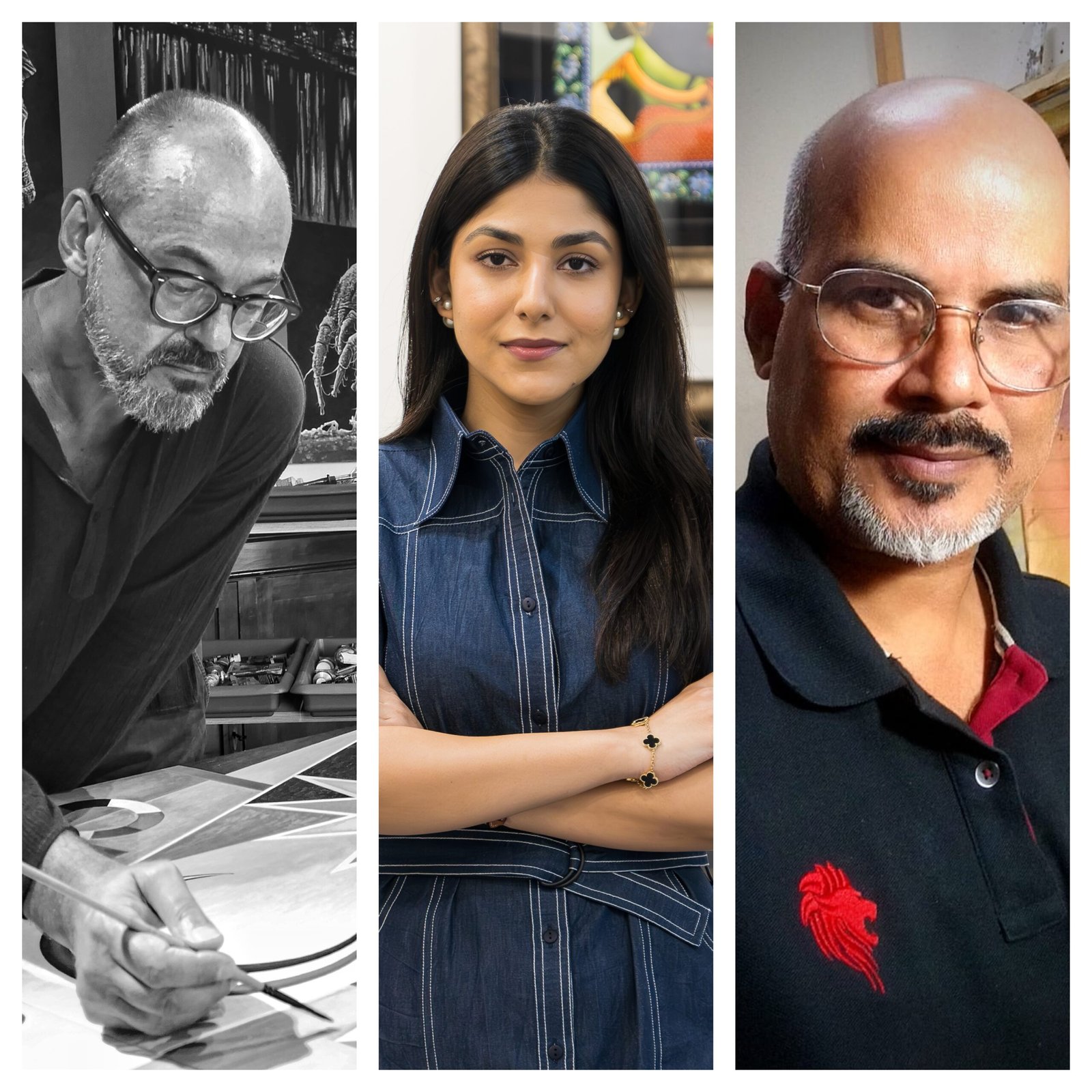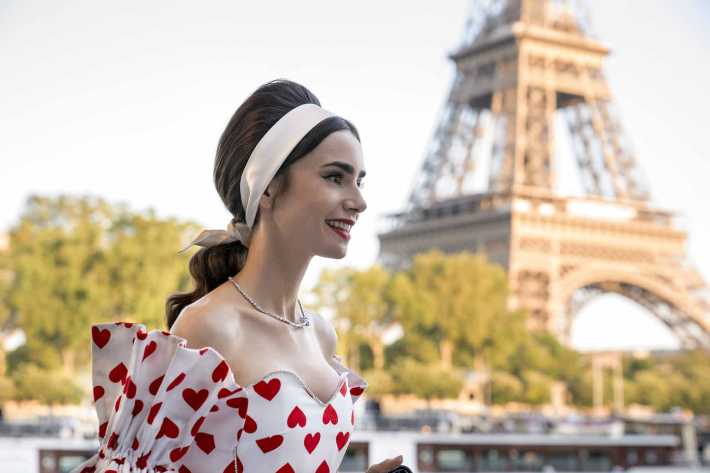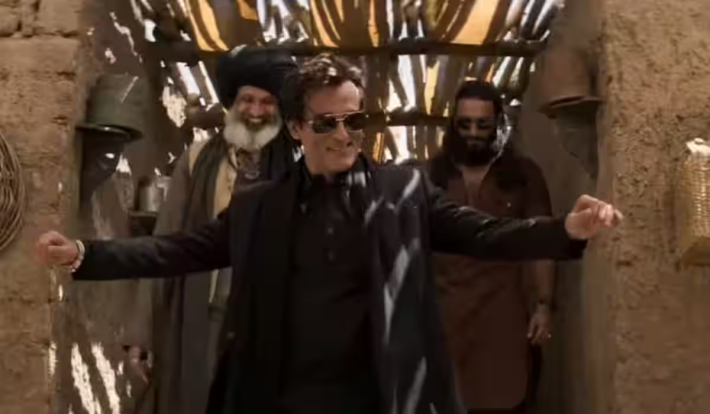‘Kindred Dichotomies’ (on view from April 10th to 27th, 2025)
In the eclectic heart of Hauz Khas, New Delhi, where ancient ruins brush shoulders with bohemian cafés and contemporary design, the newly launched Black Cube Gallery by Sanya Malik is fast becoming a hotspot for cutting-edge art. Its second exhibition, ‘Kindred Dichotomies’ (on view from April 10th to 27th, 2025), is indeed a chromatic conversation across continents, time periods, and personal histories.
In an exclusive for TheGlitz, Sumita Chakraborty, Editor-in-chief, caught up digitally with gallerist Sanya Malik, along with participating artists Sudhanshu Sutar (India) and Andrea Zucchi (Italy), to dive into this compelling visual dialogue that transcends language but speaks fluently in shades, symbols, and stories.
Artist Sudhanshu Sutar paints with the muted opulence of a forgotten royal court, each brushstroke layered with sepia-toned memory and regal melancholy. His theatrical compositions, steeped in Odisha’s lost narratives, are brought to life with deep indigos, antique golds, and shadowy vermilions, evoking grandeur, loss, and rebirth all at once.
In contrast, Andrea Zucchi enters the frame with a palette that pulses like neon history. Andrea’s works are explosions of surreal juxtapositions and riotous hues… saffron colliding with fuchsia, classical portraits interrupted by technicolor interventions. Zucchi calls it “psychedelic plagiarism,” but it’s more like visual time-travel, where everything is reimagined.
And yet, despite their wildly different approaches, Sudhanshu’s melancholic reverence and Zucchi’s irreverent color-play, their art engages in a striking symphony of opposites. As Sanya Malik puts it, “We’re interested in practices that blur boundaries—be it cultural, temporal, or conceptual. Kindred Dichotomies aligns perfectly with that ethos.”
Indeed, at its heart, ‘Kindred Dichotomies’ is a tribute to the power of art to connect, challenge, and converse. Through archival fragments, mythic echoes, and chromatic provocations, the exhibition dares viewers to see history not as a fixed narrative, but as a canvas open to reinterpretation. Here, Sanya Malik and artists Sudhanshu Sutar and Andrea Zucchi give us their perspectives of ‘Kindred Dichotomies’.
‘Kindred Dichotomies’ Unplugged! – Sanya Malik, founder and director of Black Cube Gallery

Black Cube Gallery is relatively new on the scene—what was your founding vision for the space, and how does ‘Kindred Dichotomies’ align with or expand that vision?
When we founded Black Cube, the vision was simple but ambitious: to create a space that fosters nuanced, cross-disciplinary conversations through modern and contemporary art. We’re interested in practices that blur boundaries—be it cultural, temporal, or conceptual. Kindred Dichotomies aligns perfectly with that ethos.
It brings together two artists who, on the surface, have little in common, yet their works speak to each other in surprising, powerful ways. It challenges viewers to think deeply, while also offering an accessible entry point into larger global conversations around history, identity, and visual storytelling.
The pairing of Sudhanshu Sutar and Andrea Zucchi is unconventional yet compelling. What drew you to bring these two artists together for this show, despite their vastly different backgrounds?The idea sparked when I saw Zucchi’s work last summer—it instantly reminded me of Sudhanshu Sutar’s visual language. Despite coming from different continents, their practices engage with history in ways that are both poetic and provocative.
Sutar is grounded in the layered heritage of Odisha and royal memory, while Zucchi deconstructs classical imagery with a wry, postmodern sensibility. Their differences actually created the perfect tension—a kind of visual conversation that felt both relevant and urgent. It was about finding connection in contrast.
There’s a fascinating undercurrent of cross-cultural dialogue in this exhibition. How do you, as a curator and gallerist, approach such complex narratives while ensuring they remain accessible to Indian audiences?
It starts with trust—trusting the intelligence and emotional intuition of our audience. We never want to oversimplify, but we also don’t want to alienate. Our approach is layered: visually engaging for someone walking in with no context, but rich enough for deeper contemplation.
With Kindred Dichotomies, we worked hard on contextualising the works without over-explaining. There’s something universal about the way both artists treat memory and time—it doesn’t require cultural translation, just a willingness to engage.
Both artists rework and reinterpret historical imagery in bold ways. What does this say about the role of contemporary art in re-examining the past—and how important is that in India’s current cultural landscape?
Contemporary art has become a powerful lens for revisiting the past—especially in a country like India, where history is never just history, it’s also politics, identity, memory, and myth. Sutar and Zucchi both use archival imagery not to preserve it, but to question it, reshape it. That’s crucial today.
We’re in a moment where people are re-evaluating inherited narratives—whether it’s colonial legacy, cultural displacement, or the weight of tradition. Art like this doesn’t offer easy answers, but it does open space for reflection and critical thinking.
Hauz Khas is steeped in history and buzzing with creativity. How has the location shaped the identity and experience of Black Cube Gallery?
Hauz Khas has this incredible dual energy—it’s both ancient and alive. You have the ruins and the lake just steps away from vibrant design studios. That juxtaposition—past and present coexisting—mirrors the kind of programming we’re drawn to at Black Cube.
What’s next for Black Cube Gallery after ‘Kindred Dichotomies’? Are there any upcoming exhibitions or collaborations you’re particularly excited about?
There’s a lot on the horizon that we’re truly excited about. Up next is Metamorphosis, a large-scale solo exhibition by contemporary artist Phaneendra Nath Chaturvedi, which will be held at Bikaner House from May 3–9, 2025. Following that, we’ll be presenting a solo show by Yashika Sugandh in September, also at Bikaner House. Post the summer, we’re curating a women artists’ group exhibition, a contemporary group show, and another solo featuring a prominent modern Indian artist.
As a gallery, we’re committed to creating thoughtful, dynamic programming that challenges and engages, and 2025 is shaping up to be one of our most ambitious years yet.
ANDREA ZUCCHI

Your approach has been described as “psychedelic plagiarism”… a provocative term. Can you elaborate on what that means to you and how it informs your artistic process?
It’s a term I had used years ago and I don’t want to give it too much meaning, however it actually describes my approach to using images very well. I rarely create images out of thin air; more often than not, I appropriate existing photographic images and translate them into paint by juxtaposing them with other subjects or completely altering the color palette.
My use of very bright and sometimes acidic colors I believe stems from my love of mid-16th-century Italian Mannerist painting, prints of Indian gods, and 1960s psychedelic graphics that influenced me greatly as a boy.
Unlike photography I believe that painting has a greater ability to arouse in the viewer a suspension of the flow of thoughts that for a few moments leads us into a state of meditation and contemplation. In a sense, painting for me is a psychedelic agent that can open up new channels of vision of reality for us.

You often use historical imagery, but inject it with surreal colors and playful juxtapositions. What draws you to reworking the past in such visually unexpected ways?
I really love the layering, the co-presence and contrast of different realities, so I try to recreate that in my works. Perhaps there is also the influence of science fiction, I think of those scenes in Kubrick’s “2001 A Space Odyssey” where you see an astronaut in a very modern room of mirrors and furnished with rococo furniture, or the extraordinary comics of Moebius.
In this sense our age is an incredible apotheosis of this mixture of past and present. I just try to isolate these juxtapositions and make them more obvious, but really we have them before our eyes every day.

‘Kindred Dichotomies’ pairs you with Indian artist Sudhanshu Sutar. How did you navigate this visual dialogue across cultures, and did anything about his work resonate with your own?
I just learned about Sudhanshu Sutar’s beautiful work through this exhibition, but I think the pairing chosen by Black Cube Gallery is really successful. We definitely share an intense color palette, the use of historical imagery and love of India, and a certain surrealist-derived attitude.
I am very curious to ask Sutar if he is familiar with De Chirico, an Italian painter who was the inventor of metaphysical painting, who greatly influenced me and whom I also find in his work. I am looking forward to seeing our paintings exhibited together and I am sure they will work very well.
Your art seems to question authenticity, originality, and the very idea of historical truth. Do you see your work as a form of visual critique or even satire of cultural memory?
I respect cultural memory very much, and it is not my intention to criticize anything, but I love irony very much, as long as it is subtle and well calibrated. But certainly in my work, the concept of authenticity and originality is central. I am not interested in being original but authentic.
The idea of appropriation is I think absolutely central to contemporary art starting with Picasso and African art and Duchamp’s Ready-Mades. I appropriate existing photographic images and make them my own. I am fascinated by how an image is transformed by going through its multiple reproductions.
And in the technological age of copy and paste and remix, this is a very timely theme that cannot be escaped. Paradoxically, it brings to mind the criticism of the ancient Greek philosopher Plato, who condemned artists for copying objects that were themselves copies of an eternal and transcendent reality that belongs to the world of ideas.
How do you select the archival photographs and symbols you work with? Is there a method behind the madness or do instinct and spontaneity guide your choices?
I am very systematic in my search for subjects to explore and reproduce and proceed in very consistent but also very different cycles. I choose my subjects instinctively but then I reason about them.
I am attracted to everything that I do not know and is far from my everyday world. Figures, landscapes and animals that are exotic to me, characters from the past, scenarios of the future, esoteric and spiritual symbols. I project into painting my desire for adventure, knowledge of the unknown and spiritual quest.
As an artist based in Milan, what was your experience showcasing in New Delhi, and how do you hope Indian audiences interpret or engage with your work?
I deeply love India, I have visited it several times, although of course my knowledge of your country is very limited and superficial. However, I think there is a very strong affinity between Italy and India, we are two countries with a very ancient history and an incredible stratification of cultural, artistic and spiritual traditions, and both very creative and chaotic.
I would be really very happy if my work is appreciated in India.
Sudhanshu Sutar

Your work often draws from Odisha’s royal past and forgotten narratives. What personal or cultural memories drive you to resurrect these lost histories through your art?
I was born into a carpenter family. My father was a school teacher who taught Odia literature, and my grandfather was a multitasking creative person in rural areas. My grandfather always loved doing thankless jobs to entertain people—especially during festival seasons. He created idols for Durga Puja, Ganesh Puja, Kartikeya Puja, and designed very innovative puja pandals using rural creative technology (jugad). Before that, he was a carpenter at the king’s palace, and I remember his stories of that time fondly.
My father, a literature teacher, was also a theatre play scriptwriter, theatre director, and expert stagecraft designer. Fortunately, my hometown—Rajkanika—has a beautiful royal palace, planned architecture, roads, canals, plants, natural jungle, rivers, the sea, Olive Ridley turtle beaches, and crocodiles. It also includes Bhitarkanika National Park.
Kanika was a king’s state—Rajkanika was the capital of Kanika. Bhitarkanika was an internal state of Kanika. During British colonial rule, many officers frequently visited my place. I heard many stories from our elders. Since childhood, I’ve collected many surrealistic concepts in my mind. I’ve just been struggling with how to express them in visual language.
I used to draw murals in charcoal on the backside of my straw house (miti ki makan). My parents and the village people appreciated and encouraged me. I always carry this nostalgia in my mind and express it in my work.

Your paintings have a theatrical, almost set-like quality. Could you talk about how stagecraft or visual storytelling influences your composition and style?
Being a child of a carpenter family, we always planned, calculated, and evaluated before doing any work. My father’s role as a literature teacher, scriptwriter, storyteller, and stagecraft designer was a big influence on me.
It’s very interesting to me—composing stories, drama, impossible and possible thoughts, and how to connect with a common soul. I have always felt that difficult thoughts are very easy to portray, but easy thought processes are very difficult to express—how to connect to the common soul. That is the space I always search for in my work.
In ‘Kindred Dichotomies,’ your work enters into dialogue with Andrea Zucchi’s, an artist from a very different context. How did this cross-cultural pairing influence your thinking or creative process?
Knowingly or unknowingly, both Andrea Zucchi and I have very similar thought processes. He is from Italy and thinks about the kings of our Indian history.
Zucchi is a very talented artist living in Milan. We sing together in the same notes through different cultural instruments. There is definitely a correlation between two different places where work and living processes are totally different – This is what is very interesting for both sides.
I really thank Black Cube Gallery for giving me the opportunity to collaborate in an exhibition with Mr. Andrea Zucchi—being together on one platform is wonderful.
You frequently engage with archival material. How do you choose what to reimagine, and what role does reinterpretation play in preserving or challenging historical memory?
Yes, sometimes I recollect the memories of my past. Today’s archival materials are part of the pasts contemporary living material, and I find that visually appealing. Now when I see items and stories preserved in our king’s palace—That archival material depicts the royal and romantic correlation in my paintings.
Imagination of past royal historical folklore is something that inspires me and I use this in my paintings to support the characters I portray.
There’s a dignified grandeur in your portrayal of lost royalty and shifting identities. Do you see your work as a kind of cultural restoration or resistance to forgetting?

One of the most noble incarnations of a people’s genius is its cultural heritage, built up over the centuries by the work of its architects, sculptors, painters, engravers, goldsmiths, and all the creators of forms—who have contrived to give tangible expression to the many-sided beauty and uniqueness of that genius.
The vicissitudes of history have nevertheless robbed many peoples of a priceless portion of this inheritance, in which their enduring identity finds its embodiment.
I call on historians, writers, scriptwriters, theatre personalities, and artists to come together and work for cultural restoration—otherwise, we risk forgetting our past.
What excites you most about the contemporary Indian art scene today—and where do you see your own practice heading in the coming years?
In the contemporary Indian art scene, I always search for indigenous literature, cultural motifs, techniques, symbols, and the latest theatrical themes and styles. I always believe in life lessons, the realization of literature and poetry, and creating visual imagination as a fresh way of looking at the world through conceptual approaches. Of course, research and the exploration of multiculturalism will continue guiding my practice in the coming years.













